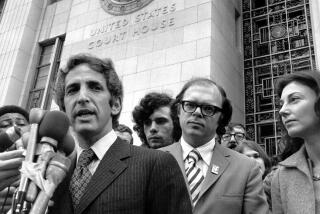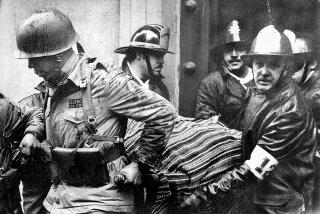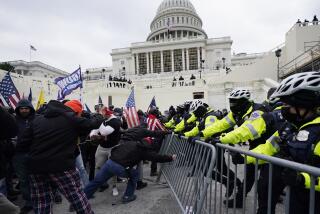Panel to Probe Data Given to Reno Before Waco Attack
WASHINGTON — After eight grueling days of congressional hearings into the 1993 debacle near Waco, Tex., one overriding question arises: Did the FBI give Atty. Gen. Janet Reno adequate and accurate information before she approved the final assault?
Reno is expected to face that question when she takes her seat at the witness table Tuesday, the last day of the hearings.
So far the hearings have shed light on the longest and deadliest siege in the history of American law enforcement. Four federal agents and about 80 members of the Branch Davidian sect, including leader David Koresh, died. The siege ended with an outbreak of fires that devoured the living quarters of the Davidians.
The congressional panel’s co-chairman, Rep. Bill McCollum (R-Fla.), said the hearings have raised “disturbing concerns” regarding the “quality” of information Reno and other officials in Washington received in the crucial final days of the siege.
And the other co-chairman, Rep. Bill Zeliff (R-N.H.), suggested Sunday that the GOP plans to look not only at Reno but also at President Clinton’s role in the decision.
“We believe there is information we can show this week that indicated that he wanted to be informed every step of the way,” Zeliff said on NBC-TV’s “Meet the Press.” “I don’t believe Janet Reno, who had less than two weeks on the job, made this decision all by herself.”
Another committee member, Rep. John Shadegg (R-Ariz.), said the panel needs to question Reno precisely about the information she was provided in the spring of 1993.
Reno “desperately, desperately wanted to avoid this confrontation” at Waco, Shadegg said in an interview. “. . . This is not a woman who was willing to risk what ultimately happened in order to end this thing.”
Available evidence to date, including testimony from federal agents, information in government documents and interviews conducted by The Times, suggests that Reno authorized the April 19, 1993, assault with less than a complete view of the events that were unfolding.
For instance, Reno told reporters last week that she approved a tear-gas attack after learning that the FBI’s chief negotiator at Waco saw “no indication whatsoever” of success in continued talks with Koresh and the Davidians about ending the standoff.
But the FBI negotiator, Byron A. Sage, testified at the hearings that although he doubted Koresh would surrender, “I never abandoned the concept or the hope that negotiations could successfully and peacefully resolve this matter. . . . I felt [as of April 15, 1993] that we were at an impasse . . . not that it was completely over.”
Reno also has said she approved the assault on the basis that once the first round of tear gas was launched into the living quarters, the FBI would back off and allow the Davidians to either evacuate or to resume negotiations by telephone. Reno has noted that the plan called for the gradual launch of more CS tear gas over 48 hours.
Yet the FBI’s on-site commander, Jeffrey Jamar, has highlighted another aspect of that plan: If the Davidians fired on the first combat vehicle that approached with the tear gas, the FBI would immediately, using six tanks, launch gas into all windows of the compound.
According to his testimony to the congressional committee, Jamar fully expected the Davidians to fire on the first combat vehicle. Such an act by the Davidians would--and did--trigger an escalated FBI response, not the gradual approach Reno envisioned.
The chance was “99%,” Jamar said, that the Davidians would fire on the first tank. “I believed that at the time, yes,” he said.
Carl Stern, a spokesman for Reno, said Friday that neither the attorney general, then-FBI Director William S. Sessions nor other top FBI officials were informed in advance that Jamar saw such a likelihood.
Reno and other Justice Department officials have said that the attorney general was aware of a surrender proposal brought forward on April 14, 1993, by Koresh’s lawyer. The proposal included a signed letter from Koresh, which was delivered by tank from inside the compound to the FBI and then to the lawyer.
It is unclear, however, the extent to which FBI officials conveyed that surrender proposal to Reno before she approved, on April 17, 1993, the tear-gas assault that followed two days later.
Stern has said that a thick briefing book regarding the pending assault, provided to Reno on April 17, contained references to the surrender proposal. According to a subsequent Justice Department review of the Waco incident, published in the fall of 1993, Reno did not delve into details.
“The attorney general did not read the prepared [briefing] statement carefully, nor did she read the supporting documentation provided along with the statement,” said the Justice Department review. “She read only a chronology, gave the rest of the materials a cursory review and satisfied herself that ‘the documentation was there’ ” to justify launching the assault.
The question of whether Reno was provided with a complete understanding of the surrender proposal is important to members of the congressional committee because Reno earlier had voiced reluctance to approve the assault unless all other means of resolving the crisis had been exhausted.
“Why now? Why not wait?” Reno had asked her subordinates on April 12, according to the Justice Department review.
Jamar and Sage, the FBI’s top negotiator, testified that they placed so little credence in the surrender proposal that they did not feel it was necessary to relay the offer to Reno.
But both Jamar and Sage confirmed in their testimony that Jamar told Koresh’s lawyer on April 14 that there was still ample time to negotiate an end to the siege.
“We have all the time it takes,” Jamar told Koresh’s attorney, Dick DeGuerin, in the presence of Sage and another official that afternoon at the FBI’s command post at Waco.
The proposal, which DeGuerin negotiated with Koresh, called for Koresh to surrender upon his completion of a manuscript on the Seven Seals prophecy in the biblical Book of Revelations. DeGuerin told the FBI that it would take Koresh about two weeks to complete the work.
Asked about the surrender proposal at the news conference, Reno said she was told the offer amounted to this: “Koresh saying: ‘Let me finish the Seven Seals and I’ll come out.’ But again and again, he had said he would come out and did not come out.”
Reno’s comments were consistent with those of Jamar, who testified last week that officials dismissed the surrender offer as a ploy because they did not believe that Koresh had made any progress on the Seven Seals manuscript.
However, a computer disk confiscated by federal agents from the clothing of Branch Davidian survivor Ruth Riddle shortly after she escaped the burning compound appeared to contain the beginning of Koresh’s work. An FBI lab found the disk contained four or five pages, consisting of an introduction, a narrative regarding the first seal and a poem, according to Ray Jahn, an assistant U.S. attorney who prosecuted some of the Davidians.
Jahn told The Times that he “presumed” the commentary on the first seal was typed inside the compound sometime between April 14, when Koresh’s attorneys presented their new “surrender plan,” and the April 19 fire.
“The question goes back to how long it would have taken” Koresh to complete the manuscript, Jahn said. “No one can answer that question in hindsight. . . . David Koresh’s God could have directed him to rewrite the Bible, write his autobiography and write ‘War and Peace.’ ”
Shadegg noted that the Justice Department review found that the FBI officials in Waco were exhausted and without qualified replacements by the time Reno finally approved the tear-gas assault.
“There may have been a motivation both above and below [Reno] to get a decision out of her to get this done,” said Shadegg, a lawyer who formerly worked in the Arizona attorney general’s office. “I don’t believe in conspiracies, but this doesn’t have to be a conspiracy. The FBI was frustrated and tired. They wanted to do something. They thought they had a good plan.”
Reno has not been publicly asked whether she knew that the FBI on April 14 had told DeGuerin: “We have all the time it takes.” Nor has the attorney general yet been asked about Jamar’s testimony that he saw a “99%” likelihood that using tear gas would provoke escalated violence.
DeGuerin, aware now that Reno approved the tear-gas assault just three days after he notified the FBI regarding Koresh’s surrender proposal, said the testimony tells him that Reno was misinformed.
“She was kept in the dark, and she was told only what those proposing the gas plan wanted her to hear,” he said in an interview.
Reno has called her approval of the final assault the most difficult decision in her life. The attorney general, who inherited the crisis upon taking office in March, 1993, addressed the matter at a news conference Thursday.
“If I knew now what I knew then and nothing more,” Reno said, “I don’t know any other way I would have approached it. . . . Nobody will ever know what the right answer was, but what we need to do is to take experiences like this, as I’ve said before, [and] learn everything we can from them . . . to avoid such tragedies for the future.”
More to Read
Get the L.A. Times Politics newsletter
Deeply reported insights into legislation, politics and policy from Sacramento, Washington and beyond. In your inbox three times per week.
You may occasionally receive promotional content from the Los Angeles Times.











